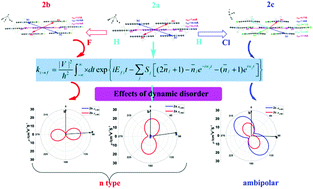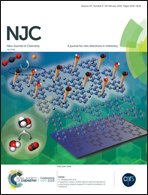Theoretical study of synergetic effect between halogenation and pyrazine substitutions on transport properties of silylethynylated pentacene†
Abstract
Combining quantum-tunneling-effect-enabled hopping theory with kinetic Monte Carlo simulation and dynamic disorder effects, the charge transport properties of a series of N-hetero 6,13-bis(triisopropylsilylethynyl)pentacene (TIPS-PEN) derivatives with halogen substitutions were studied. Based on the single molecule and the theoretically predicted crystal structure, the electronic structures and nuclear dynamic disorder effects of halogen and aza systems and their impacts on the charge transport behaviors were expounded. On the one hand, this study revealed the regularity of carrier transport by substitution with one or two pyrazine rings from the external toward the internal for benzene rings in TIPS-PEN, suggesting the substitution of two internal pyrazine rings can sharply shrink the hole transport features. Meanwhile, internal pyrazine rings improve the electron transport performance mainly by enhancing air stability and compacting π-stacking. On the other hand, the investigation elaborated the delicate tuning effect of chlorination on two kinds of carrier transports based on aza-TIPS-PEN derivatives, indicating chlorination can effectively equilibrate the electron and hole reorganization energies and decrease the slip distances along the molecular long and short axes in favor of the similarity in the hole and electron transfer integral values, thereby yielding increasingly balanced ambipolar transport characteristic. The coordination of monopyrazine substitution and chlorination on the acene is an effective way to acquire ambipolar transport properties. In addition, the nuclear dynamic disorder effect affects the hole transfer integral more than the electron transfer integral. In the case of the comprehensive consideration of both ease of charge injection and intrinsic transport mobility, both 8,9,10,11-tetrafluoro-6,13-bis((triisopropylsilyl)ethynyl)naphtho[2,3-b]phenazine (2b) and tetrachloro-6,13-bis((triisopropylsilyl)ethynyl)quinoxalino[2,3-b]phenazine (3c) exhibited to be electron-dominant materials, while 8,9,10,11-tetrachloro-6,13-bis((triisopropylsilyl)ethynyl)naphtho[2,3-b]phenazine (2c) showed effective ambipolar transport characteristics with average hole/electron mobility of 3.64/2.21 cm2 V−1 s−1.



 Please wait while we load your content...
Please wait while we load your content...